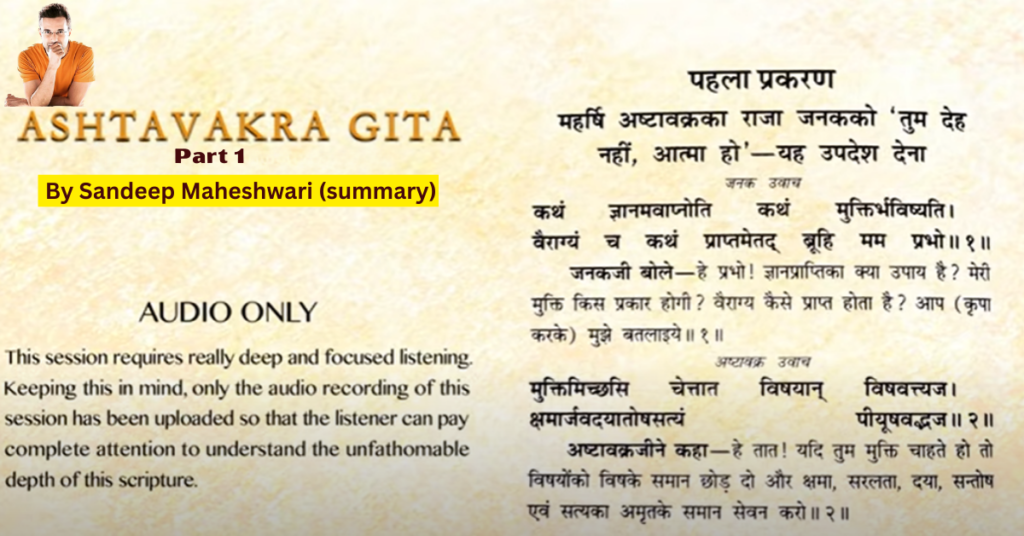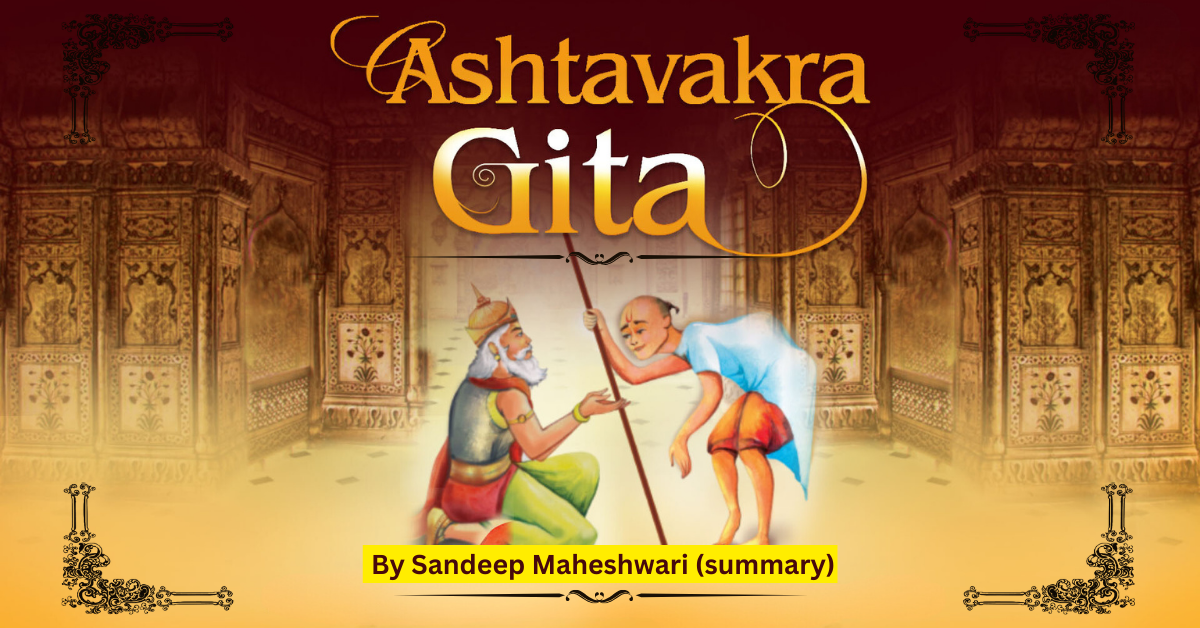ASHTAVAKRA GITA in English Part 1 By Sandeep Maheshwari
The Essence of Togetherness
Before we embark on the enlightening journey of Ashtavakra Gita, let’s pause for a moment. Imagine a path leading to self-discovery, a path that requires you to shed preconceived notions and beliefs, to sit comfortably with an open mind, and to listen without distractions. This is the essence of togetherness in understanding profound truths, the core message of Ashtavakra Gita.
In this article, we will delve deep into the wisdom of Ashtavakra Gita, exploring its key teachings on self-knowledge, salvation, and the art of living in the present moment.

Setting Aside Preconceived Notions : seeing things as they are
At its core, the Ashtavakra Gita is about understanding reality as it really is. It requires us to sit comfortably with an open mind and listen carefully.
Often, we are burdened with preconceived notions that hinder our understanding. These assumptions can lead us to think, “This isn’t for me,” “I already know this,” or “It’s too complicated.” To truly understand the teachings of the Ashtavakra Gita, we have to set aside these notions.
Art of listening
To truly understand the teachings of the Ashtavakra Gita, we must first understand the importance of listening. Listening is not just hearing words; It is about seeing, understanding and testing. To truly listen, one must silence the distracting noise and proceed with an open mind. Through this deep listening you can understand the authenticity of what is being told. Is it a subjective perspective, influenced by personal motives and hidden agendas, or is it a representation of reality, a truth that can be universally reaffirmed time and again?
Liberation from Restlessness
One of the prevalent issues addressed by the Ashtavakra Gita is restlessness of the mind. The mind, often likened to restlessness itself, seldom finds stillness. This perpetual state of motion stems from the belief that we must constantly strive for something—be it a destination, a goal, or an identity.
The Solution: Staying Where You Are
Ashtavakra offers a profound solution to our existential quandaries: stay where you are. The relentless pursuit of external goals is based on the misconception that we need to “go” somewhere or become something else. In reality, our essence is complete and whole, needing no alteration.So the solution to all this is to stay where you are. It doesn’t matter who you are, you don’t have to do anything. Your problem is that you think you have to go somewhere.
For example, you might think I want to achieve enlightenment. Now what is enlightenment? Everyone’s definition of enlightenment will be different. Everyone has some preconceived notions in their mind that if I can achieve this then I will attain enlightenment or when I will see the light. I will become enlightened. Suppose you see light. Is this the end of restlessness?
Why read Ashtavakra Geeta?
We all basically face two types of problems – the first being subjective problems at the surface level. Which you may have but I don’t or I may have but you don’t which means one person may have that problem but another may not.
On the contrary, there are some problems which we can call fundamental problems at a deeper level, which are with every person, whether he is the poorest or the richest, whether it is India or America, Britain, really anywhere. There will not be a single person who is not suffering from these problems, these are the problems for which we have to find solutions, actually all the questions you ask are from your own perspective like I have this problem or I am suffering from this or that. I am suffering but we never asked whether I am really suffering or not.
Ashtavakra Gita teaches us that these fundamental problems can be solved only through self-enquiry. It inspires us to question our existence and purpose, to look beyond the surface layers of life and find truth in its purest form.
The Essence of Ashtavakra Gita
Ashtavakra Gita’s teachings are encapsulated in the dialogue between King Janaka and Ashtavakra. King Janaka, a symbolic representation of anyone seeking truth, asks direct questions about attaining self-knowledge, salvation, and self-control. Ashtavakra’s responses are succinct and devoid of convoluted narratives.
Let us now start with Ashtavakra Gita
There are many stories related to this in which I will not go into right now who was Ashtavakra, who was King Janak but the most important thing that needs to be understood is that King Janak was not a specific person as every ruler of that kingdom was called Janak.
The Story of Janak and Ashtavakra
Before delving into the teachings of Ashtavakra Gita, it’s essential to understand the context in which this timeless dialogue unfolds. King Janak, not to be confused with a specific individual but rather a symbol of every seeker of truth, is filled with burning questions. He approaches Ashtavakra, a sage renowned for his deep understanding of the self and the universe.
With utmost humility, King Janak beseeches Ashtavakra, “Oh Lord, how do I attain self-knowledge, how do I attain salvation, how do I attain self-control?” These questions form the crux of all Vedic and Upanishadic wisdom, and they resonate with seekers across the ages.

The Directness of Ashtavakra Gita
The beauty of Ashtavakra Gita lies in its directness. It eschews complex systems and convoluted rituals, offering straightforward answers to life’s most profound questions. It begins precisely where most spiritual paths culminate – at the ultimate destination. How does one attain self-knowledge? What is the path to salvation? How can we achieve self-control? Each of these questions demands a deep understanding, as preconceived notions often cloud our comprehension.
Redefining Preconceived Notions
The concept of salvation, often referred to as “moksha,” carries stereotypical notions that hinder our understanding. Moksha is not reserved for the select few or superhumans. It does not require us to meditate endlessly or renounce the world. Instead, it beckons us to realize that there is no bondage, only freedom.
Solution: Self-Knowledge and Renunciation
As we seek solutions for self-knowledge, we must redefine our perception of the term “solution” itself. In the Ashtavakra Gita, the solution is not a set of practices or rituals but rather a profound understanding of the self. The ultimate goal is salvation, and the path to it is through renunciation.
Renunciation, in this context, does not mean forsaking everything abruptly. It implies a shift in our perspective. We should question our beliefs, neither clinging to them as absolute truths nor dismissing them as entirely false. Instead, we place question marks on our beliefs, adopting a neutral stance that allows us to explore without bias.
Embracing the Middle Path
As Ashtavakra advises, “If you want salvation, then give up the objects of the senses as if they were poison and embrace forgiveness, simplicity, kindness, contentment, and truth as nectar.” However, these words have often been misinterpreted, leading many astray.
People tend to weave stories around such teachings, imagining that renunciation means abandoning everything, including basic necessities and relationships. This misconception arises from our penchant for storytelling. Instead, we must grasp the essence of these teachings.
Moderation and Clarity of Purpose
Ashtavakra’s guidance urges us towards moderation. It encourages us to recognize that the objects of our senses are not inherently harmful, akin to medicine. Just as taking too much medicine can be detrimental, so too can excessive indulgence in sensory experiences. It’s about finding the right balance, for it is within moderation that true self-discipline resides.
We must also clarify our understanding of means and ends. Money, for instance, is a means to an end, not the end itself. It serves the purpose of leading a comfortable life, which, in turn, allows us to explore our true selves without the burdens of material concerns.
The Path to Abstinence
Renunciation, in its truest form, does not necessitate detachment from the world but rather a shift in perspective. We should view everything in the world as fuel for our journey towards self-discovery. Our ultimate goal is to understand the self and the root of our struggles. Everything in the world becomes akin to the fuel required by a vehicle for this transformative journey.
In essence, renunciation is not about giving up but about embracing a balanced life where we neither indulge excessively nor abstain completely. It is about finding peace and tranquility within this equilibrium.
Conclusion
The wisdom of Ashtavakra Gita (ASHTAVAKRA GITA By Sandeep Maheshwari) provides a roadmap for self-knowledge and salvation that transcends cultural and temporal boundaries. By understanding the true essence of renunciation, moderation, and the distinction between means and ends, we can embark on a transformative journey towards self-discovery and spiritual liberation.
In a world filled with distractions and misconceptions, the teachings of Ashtavakra Gita offer a timeless guide to unlocking the profound truths of existence. To achieve true self-knowledge and spiritual liberation, we must embrace the middle path, recognizing that everything in the world is but fuel for our journey towards understanding the self.
